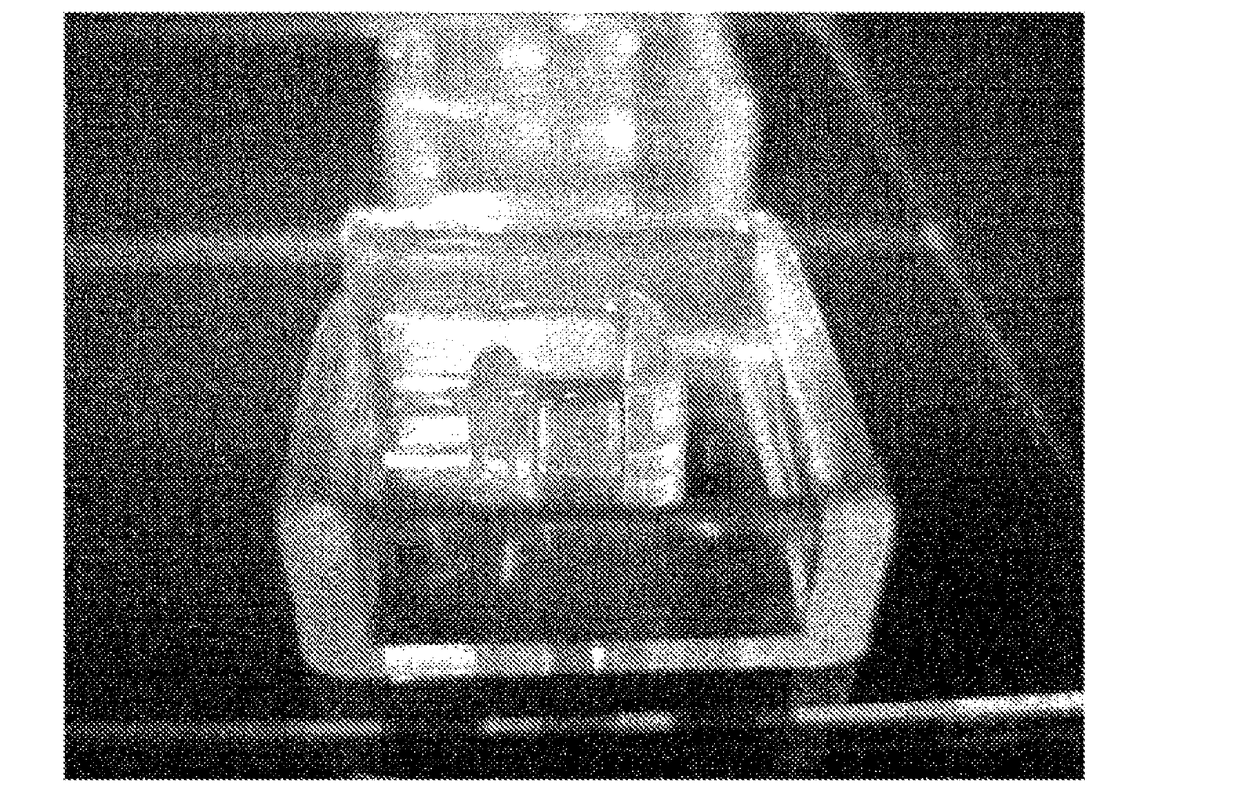However, the conventional
processing methods are increasingly meeting their limits when silicone moldings of more complex geometry, of different material composition and / or of variable profiles of properties are required.
The general trend toward individualization and
individual adjustment of everyday articles is additionally requiring smaller numbers of items (e.g. prototypes, individually adapted prostheses, etc.), the necessity of rapid availability and simple
changeover to new product series, which means that conventional methods are no longer efficient.
With regard to the rheological demands that jetting and dispensing make on the material to be printed, jetting is found to be significantly more demanding.
A
disadvantage of this process is the unachievable spatially exact positioning of ultrasmall
silicone rubber compositions for the printing of fine details.
Furthermore, it is no longer possible to influence the juncture of crosslinking after the mixing of the two rubber components, one
disadvantage of which is that, in the course of the printing operation, regions of the
silicone rubber composition having very different degrees of crosslinking are brought into contact (when the
processing time for the rubber composition is shorter than the printing time), or that the printed structure is not self-supporting (
processing time longer than printing time).
This recycling of the material to be printed, in the case of crosslinkable silicone rubber compositions, as well as the
contamination risk, has the serious danger of bulk alteration of the rheological properties owing to incipient crosslinking and is therefore impracticable.
However, the method described is unsuitable for production of moldings consisting of
silicone elastomers.
Firstly, the photoinitiators, photosensitizers, coinitiators etc. that are used have only sparing
solubility in the (nonpolar) silicone compositions, which leads to cloudiness, microphase separation and inhomogeneity.
As is well-known, the free-radical curing of silicones functionalized with the aforementioned photocrosslinkable groups has the problem of inhibition caused by
oxygen, which considerably lowers the crosslinking rate and results in tacky surfaces.
If this effect is counteracted by increasing the function density of
acrylate groups, for example, the result is nonelastic, brittle vulcanizates.
Finally, the extremely high local
photon density which is required for multiphoton
polymerization (especially as a result of the low function density of photopolymerizable groups) and is generated by means of pulsed
femtosecond lasers causes breakdown reactions (
carbonization) in the silicone, which leads to unacceptable discoloration and damage to the material.
Since the frequency with which the printhead produces the droplets is limited, the use of smaller droplets will, however, inevitably lead to longer production times for the molding, and so a compromise has to be made in the individual case between dimensional accuracy and production time.
It is generally the case that low-
viscosity compositions permit the jetting of smaller droplets with higher frequency, whereas higher-
viscosity compositions cause the currently available printheads to rapidly reach their limits.
Even though the manufacturers of the print valves specify processible viscosities of up to about 2 million mPa·s (at low
shear rate), materials of such high
viscosity can generally only be jetted in the case of extremely shear-
thinning characteristics.
If the shear-
thinning characteristics of the high-viscosity material are too low, the energy of the piezo print valve is insufficient to force the material through the
nozzle and the printhead becomes blocked.
If the material thread becomes detached at the
nozzle outlet and subsequently combines with the main droplet, the result is a single drop, the speed of which slows considerably owing to the elastic combining process.
On the other hand, the position of the droplet at an
exact location is adversely affected with increasing
time of flight, and therefore, in practice, it is necessary to find an optimal distance between the nozzle and substrate, which is typically in the region of a few millimeters.
If the material thread does not become detached immediately at the nozzle outlet (which is determined to a crucial degree by the interfacial tension that exists between the nozzle material and printing material), the portion of the material thread remaining at the nozzle outlet will contract, resulting in blockage of the nozzle, which leads to failure of the printhead.
This splashing also leads to an unclean print.
On the other hand, excessively rapid relaxation to the high starting viscosity in the presence of a yield point can lead to droplet shapes like a conical hat, having a
rough surface for lack of adequate leveling.
Shear-thickening rheological characteristics of the droplet can even lead to rebound of the impacted droplet.
Both of these lead unavoidably to silicone rubber compositions having relatively high viscosity, which is a barrier to clean droplet formation in jetting.
Increasing viscosity makes the rapid detachment of the material thread at the nozzle outlet more difficult, meaning that the main droplet remains connected to the nozzle via the material thread for a comparatively long period, while the printhead permanently moves onward.
Secondly, for the rapid formation of a discrete droplet in jetting, a maximum
surface tension of the material is necessary.
However, the
surface tension of silicones is among the lowest in the field of elastomers (even lower surface tensions are possessed only by perfluorinated hydrocarbons).
Because of these disadvantages in terms of viscosity and
surface tension, the production of elastomeric shaped bodies from silicone rubber compositions by the DOD jetting method was considered to be non-implementable to date.
If the typical properties of silicone rubber compositions are entered into these equations, irrespective of the choice of technical parameters of the printhead, this does not lead to the parameter range necessary for proper jetting, which suggests that jetting of silicone rubber compositions which does not meet the demands of DOD 3D printing should not be possible.
 Login to View More
Login to View More 


